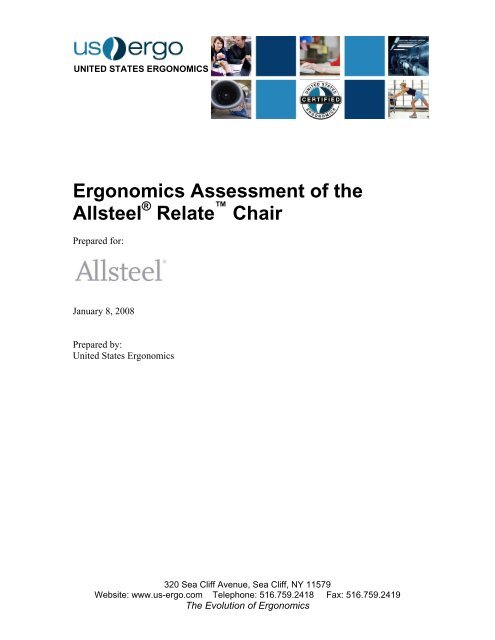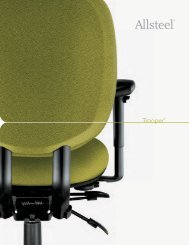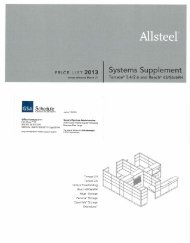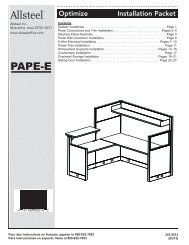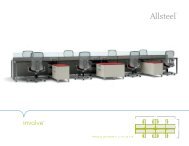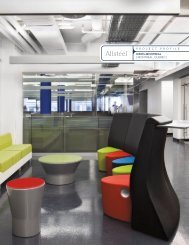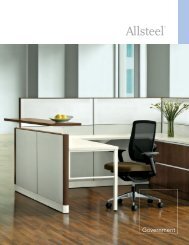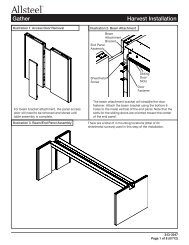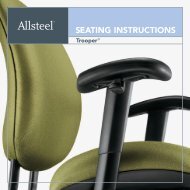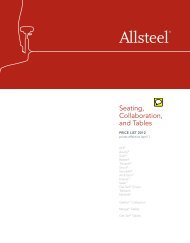Ergonomics Assessment of the Allsteel Relate Chair
Ergonomics Assessment of the Allsteel Relate Chair
Ergonomics Assessment of the Allsteel Relate Chair
You also want an ePaper? Increase the reach of your titles
YUMPU automatically turns print PDFs into web optimized ePapers that Google loves.
UNITED STATES ERGONOMICS<strong>Ergonomics</strong> <strong>Assessment</strong> <strong>of</strong> <strong>the</strong><strong>Allsteel</strong> ® <strong>Relate</strong> <strong>Chair</strong>Prepared for:January 8, 2008Prepared by:United States <strong>Ergonomics</strong>320 Sea Cliff Avenue, Sea Cliff, NY 11579Website: www.us-ergo.com Telephone: 516.759.2418 Fax: 516.759.2419The Evolution <strong>of</strong> <strong>Ergonomics</strong>
<strong>Ergonomics</strong> <strong>Assessment</strong> <strong>of</strong> <strong>the</strong> <strong>Allsteel</strong> <strong>Relate</strong> <strong>Chair</strong>Table <strong>of</strong> ContentsExecutive Summary............................................................................................................ 21.0 OVERVIEW ........................................................................................................... 32.0 EXPERT ERGONOMICS REVIEW ..................................................................... 32.1 Controls..................................................................................................................... 42.2 Seat Back Fit............................................................................................................. 42.2.1 Adjustable Lumbar............................................................................................. 52.2.2 Seat Back Pivot .................................................................................................. 52.2.3 Mesh Seat Back Option...................................................................................... 62.3 Seat Pan..................................................................................................................... 62.3.1 Seat Pan Height ................................................................................................. 62.4 Seat Recline .............................................................................................................. 62.5 Armrests.................................................................................................................... 72.6 Contact Pressure........................................................................................................ 83.0 CONCLUSIONS......................................................................................................... 10United States <strong>Ergonomics</strong> 1
<strong>Ergonomics</strong> <strong>Assessment</strong> <strong>of</strong> <strong>the</strong> <strong>Allsteel</strong> <strong>Relate</strong> <strong>Chair</strong>Executive SummaryThe <strong>Allsteel</strong> <strong>Relate</strong> chair was evaluated by a Certified Pr<strong>of</strong>essional Ergonomist at UnitedStates Ergonomic. The results <strong>of</strong> this evaluation indicate that <strong>the</strong> <strong>Relate</strong> chair <strong>of</strong>fersseveral beneficial ergonomic features. These are summarized as follows:o Beneficial featureso Adjustable resistance free floating and lockable tilt feature promoteshealthy motion and promotes circulationo The pivoting backrest provides freedom <strong>of</strong> movement and maintains seatback support during partial recline and forward leaning postures.o Simple, weight balanced recline is easy to useo Adjustable lumbar curvature point allows <strong>the</strong> chair to fit many body typeso The asymmetric lumbar adjustment can accommodate individuals withunique support requirementso Adjustable seat pan deptho Height, width, and length adjustable armrestso Mesh back provides ventilation and breathabilityThe <strong>Relate</strong> chair provides good dynamic support and provides an effective range <strong>of</strong>adjustability to meet <strong>the</strong> needs <strong>of</strong> diverse users. The weight balanced recline and pivotingseat back accommodate users throughout <strong>the</strong> normal range <strong>of</strong> working postures. Theasymmetrically adjustable lumbar provides an additional dimension <strong>of</strong> fit to meet <strong>the</strong>unique needs <strong>of</strong> individuals. The chair controls are well designed and intuitive and easyto operate.United States <strong>Ergonomics</strong> 2
<strong>Ergonomics</strong> <strong>Assessment</strong> <strong>of</strong> <strong>the</strong> <strong>Allsteel</strong> <strong>Relate</strong> <strong>Chair</strong>1.0 OVERVIEWAn expert ergonomics review has been completed on <strong>the</strong> <strong>Allsteel</strong> <strong>Relate</strong> <strong>of</strong>fice chair by aCertified Pr<strong>of</strong>essional Ergonomist (CPE) with over 20 years <strong>of</strong> product testingexperience. The purpose <strong>of</strong> <strong>the</strong> assessment was to examine <strong>the</strong> design and features<strong>of</strong>fered by <strong>the</strong> chair to determine if it meets with best practices and applicable ergonomicseating standards. The evaluation included a qualitative assessment <strong>of</strong> <strong>the</strong> chair featuresin addition to pressure distribution measurement <strong>of</strong> <strong>the</strong> support <strong>of</strong>fered by <strong>the</strong> seat.2.0 EXPERT ERGONOMICS REVIEWThe <strong>Allsteel</strong> <strong>Relate</strong> chair comes as a task chair or work stool with high-back and midbackoptions. It is available with a mesh backrest or a traditional upholstered foambackrest, and adjustable or fixed armrests are available as options. The work stoolpossesses a foot ring. The version assessed was <strong>the</strong> high-back task chair with adjustablearmrests and a mesh seat back (see below).Front Side BackA description <strong>of</strong> <strong>the</strong> seat features and results <strong>of</strong> <strong>the</strong> ergonomics review are provided in <strong>the</strong>following sections.United States <strong>Ergonomics</strong> 3
<strong>Ergonomics</strong> <strong>Assessment</strong> <strong>of</strong> <strong>the</strong> <strong>Allsteel</strong> <strong>Relate</strong> <strong>Chair</strong>2.1 ControlsThe chair provides a range <strong>of</strong> adjustability, however, <strong>the</strong> user is not overwhelmed withcontrols and knobs. The chair’s controls are well designed, intuitively placed, easy tolocate and operate. Most <strong>of</strong> <strong>the</strong> controls are unique designs for a single function. Thepaddles are comfortable to grip and require light force to actuate. The controls present on<strong>the</strong> chair include:• Seat pan height adjust• Recline lock/release• Weight balanced recline resistance setting• Seat pan depth adjustment• Independent (left and right side) lumbar support height adjustment• Armrest height• Armrest width and fore/aft adjustmentOnce set, many <strong>of</strong> <strong>the</strong> controls will not require additional adjustment for an employeeperforming a consistent task.2.2 Seat Back FitThe high-back seat back had a 17” width and a 22.5” height (measured from <strong>the</strong> seatpan). The size <strong>of</strong> <strong>the</strong> seat back is appropriate to accommodate <strong>the</strong> 5 th percentile female to95 th percentile male.Lumbar protrusionThe seat back frame is contoured effectively to provide a smooth transition <strong>of</strong> pressurebetween <strong>the</strong> mesh and <strong>the</strong> frame. The maximum seat back width for a chair withadjustable armrests is 20.25”, <strong>the</strong>reby accommodating well beyond <strong>the</strong> 95 th percentilemale.United States <strong>Ergonomics</strong> 4
<strong>Ergonomics</strong> <strong>Assessment</strong> <strong>of</strong> <strong>the</strong> <strong>Allsteel</strong> <strong>Relate</strong> <strong>Chair</strong>2.2.1 Adjustable LumbarThe adjustable lumbar provides approximately 5” <strong>of</strong> vertical adjustment <strong>of</strong> <strong>the</strong> apex <strong>of</strong><strong>the</strong> lumbar curve, <strong>the</strong>reby effectively accommodating a large range <strong>of</strong> users. Thisadjustment may be made to each side <strong>of</strong> <strong>the</strong> seat back independently, providingasymmetric support <strong>of</strong> <strong>the</strong> lumbar spine and lower back musculature. This is in additionto <strong>the</strong> built in lumbar support provided by <strong>the</strong> seat back frame contouring.The adjustment controls are easy to reach, low force, and adjust from a seated position.The flexibility <strong>of</strong> <strong>the</strong> lumbar adjustments allows <strong>the</strong> chair to fit many body typesincluding individuals with unique support requirements.Asymmetric lumbar adjustment tab2.2.2 Seat Back PivotThe seat back can pivot independently <strong>of</strong> <strong>the</strong> seat pan, enhancing <strong>the</strong> support provided by<strong>the</strong> seat back throughout a range <strong>of</strong> <strong>the</strong> user’s postural shifts. The pivot feature (see imagebelow) provides some recline and freedom <strong>of</strong> movement even when <strong>the</strong> seat tiltmechanism is locked. Pivoting also enhances <strong>the</strong> seat back support during recline bynaturally balancing <strong>the</strong> center <strong>of</strong> pressure throughout <strong>the</strong> recline motion.Seat back pivotUnited States <strong>Ergonomics</strong> 5
<strong>Ergonomics</strong> <strong>Assessment</strong> <strong>of</strong> <strong>the</strong> <strong>Allsteel</strong> <strong>Relate</strong> <strong>Chair</strong>The seat back pivot is set at approximately 9.5” over <strong>the</strong> seat pan and should comfortablyaccommodate a broad range <strong>of</strong> users.2.2.3 Mesh Seat Back OptionThe mesh seat back provides good ventilation and breathability while maintainingeffective support.2.3 Seat PanThe physical dimensions <strong>of</strong> <strong>the</strong> seat pan are 19” wide by 19.5 deep. The effective depth<strong>of</strong> <strong>the</strong> seat pan is adjustable from a minimum effective length <strong>of</strong> 16.5” to a maximum <strong>of</strong>20”. The adjustment is in approximately 0.5” increments, and <strong>the</strong> adjustment lever under<strong>the</strong> center <strong>of</strong> front edge <strong>of</strong> <strong>the</strong> seat pan is intuitive and easy to actuate. This will fit <strong>the</strong> 5 thpercentile female to <strong>the</strong> 95 th percentile male.The front edge <strong>of</strong> <strong>the</strong> seat cushion is contoured incorporating a true ‘waterfall’ design.The low-density foam compresses easily, preventing high pressure on thighs, andcombined with <strong>the</strong> highly adjustable seat pan length, <strong>the</strong> potential <strong>of</strong> contact stress islow.At 19” wide, <strong>the</strong> seat pan will accommodate large individuals ( 95 th percentile male) wi<strong>the</strong>ase. The free space beyond <strong>the</strong> seat pad sides extends to a maximum <strong>of</strong> 21.5” prior toclashing with <strong>the</strong> adjustable armrest stanchions. This will provide additionalaccommodation for individuals beyond <strong>the</strong> 95 th percentile size range.2.3.1 Seat Pan HeightThe seat pan height was adjustable between 17.25” and 22.25” measured from <strong>the</strong> center<strong>of</strong> <strong>the</strong> seat pan. Based on current practice, users typically adjust <strong>the</strong> seat height to a pointapproximately 2” above popliteal height (<strong>the</strong> height <strong>of</strong> <strong>the</strong> point behind <strong>the</strong> knee). Thehigh setting will accommodate <strong>the</strong> 95 th percentile male. The forward edge <strong>of</strong> <strong>the</strong> seat pancompresses to a height <strong>of</strong> approximately 16” in <strong>the</strong> low setting. This indicates that <strong>the</strong> 5 thpercentile female will be accommodated. For smaller users a low range seat cylinder isavailable that adjusts 15” to 18.5”.2.4 Seat ReclineThe <strong>Relate</strong> chair possesses an adjustable weight balanced recline mechanism. The freefloating feature promotes healthy motion and is expected to enhance circulation.The recline resistance is provided by adjusting <strong>the</strong> center <strong>of</strong> balance <strong>of</strong> <strong>the</strong> seat pan,controllable by a lever under <strong>the</strong> right hand side. A total <strong>of</strong> five (5) resistance settings areUnited States <strong>Ergonomics</strong> 6
<strong>Ergonomics</strong> <strong>Assessment</strong> <strong>of</strong> <strong>the</strong> <strong>Allsteel</strong> <strong>Relate</strong> <strong>Chair</strong>possible. This lever is relatively intuitive, although unmarked, and is easy to adjust. On<strong>the</strong> left underside <strong>of</strong> <strong>the</strong> seat pan is <strong>the</strong> locking lever, which prevents any recline.With <strong>the</strong> recline resistance setting set to <strong>the</strong> lowest resistance, <strong>the</strong> seat is more likely tonaturally rest in <strong>the</strong> recline position. It feels as if <strong>the</strong> seat pivots over center and comes toa stable reclined position. This is a beneficial option for individuals that prefer <strong>the</strong>reclined position for extended periods.2.5 ArmrestsThe armrests are well cushioned and are highly adjustable. The adjustment range willaccommodate beyond <strong>the</strong> 5 th percentile female to <strong>the</strong> 95 th percentile male. Theadjustments move in approximately 0.5” steps, allowing for great customization.Adjustment Minimum Maximum ForceVertical (from center <strong>of</strong> seat pan) 6.25” 10” 10 lbfFore/aft (front edge from seat back) 8” 10” 8 lbfWidth (space between) 17.75” 20.125” 12 lbfThe contours and padding <strong>of</strong> <strong>the</strong> armrests minimize <strong>the</strong> potential for ulnar nerve contactstress at <strong>the</strong> forearm or elbow (image below). Armrest height is adjusted using a wellplaced button. The fore/aft and width adjustments are friction adjustments allowing <strong>the</strong>armrest pad to be pushed into position without <strong>the</strong> need <strong>of</strong> a separate release lever. Thefore/aft adjustability enables <strong>the</strong> user to push <strong>the</strong>m full back far enough to pull <strong>the</strong> chairup to <strong>the</strong> edge <strong>of</strong> <strong>the</strong> worksurface.Illustration <strong>of</strong> Armrest AdjustmentUnited States <strong>Ergonomics</strong> 7
<strong>Ergonomics</strong> <strong>Assessment</strong> <strong>of</strong> <strong>the</strong> <strong>Allsteel</strong> <strong>Relate</strong> <strong>Chair</strong>2.6 Contact PressureSample pressure measurements were obtained from a single male subject <strong>of</strong>approximately 70th percentile stature (height=71.0” weight=182 lbs). The contactpressure was measured in <strong>the</strong> upright and reclined positions. The pressure pr<strong>of</strong>ilesrevealed pressure concentrations on <strong>the</strong> seat pan under <strong>the</strong> ischial tuberosities (see imagebelow). The peak pressures were measured at an average <strong>of</strong> 78 mmHg in <strong>the</strong> ischialregion and 37 mmHg in <strong>the</strong> thighs, indicating a good distribution <strong>of</strong> pressure peaks.Mean contact pressure levels were 35mmHg in <strong>the</strong> ischial region and 19mmHg at <strong>the</strong>thighs.Seat pan pressure mappingThe seat back pressure mapping revealed considerable contact area, a desirablecharacteristic indicating good seat back support. The flex provided by <strong>the</strong> mesh materialsand <strong>the</strong> pivoting backrest contributes to this by keeping <strong>the</strong> backrest in contact with <strong>the</strong>user during postural variations. The mesh backrest had good pressures distribution inboth upright and reclining postures. Upright, <strong>the</strong> average pressure was 9mmHg, with apeak pressure <strong>of</strong> 13mmHgUnited States <strong>Ergonomics</strong> 8
<strong>Ergonomics</strong> <strong>Assessment</strong> <strong>of</strong> <strong>the</strong> <strong>Allsteel</strong> <strong>Relate</strong> <strong>Chair</strong>Seat back pressure in upright seated postureReclining, <strong>the</strong> mean pressure was 11mmHg, with a peak <strong>of</strong> 28mmHg. This level does notindicate a risk for pressure concentration issues.Seat back pressure in reclined postureUnited States <strong>Ergonomics</strong> 9
<strong>Ergonomics</strong> <strong>Assessment</strong> <strong>of</strong> <strong>the</strong> <strong>Allsteel</strong> <strong>Relate</strong> <strong>Chair</strong>3.0 CONCLUSIONSThe <strong>Relate</strong> chair provides good dynamic support and provides an effective range <strong>of</strong>adjustability to meet <strong>the</strong> needs <strong>of</strong> diverse users. The weight balanced recline and pivotingseat back accommodate users throughout <strong>the</strong> normal range <strong>of</strong> working postures. Theasymmetrically adjustable lumbar provides an additional dimension <strong>of</strong> fit to meet <strong>the</strong>unique needs <strong>of</strong> individuals. The chair controls are well designed and intuitive and easyto operate.The pressure analyses revealed effective support provided by <strong>the</strong> seat back in both <strong>the</strong>upright and reclined positions. The pressure levels were within desirable thresholds forgood ergonomic performance.While <strong>the</strong> <strong>Relate</strong> chair is simple to use, users <strong>of</strong> all types <strong>of</strong> seating should be educated in<strong>the</strong> adjustment features and <strong>the</strong> principles <strong>of</strong> healthy seated postures.United States <strong>Ergonomics</strong> 10


